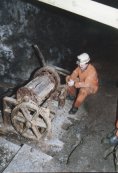| The mines of Maughold are
concentrated mainly around the headland although there are smaller less
important mines such as Barrony, Ballaglass and Ballajora within the
parish. The main group, Dhrynane, Glebe and The Maughold Head Mine along
with other smaller associated mines, worked under the Companies acts of
1862 as the Maughold Head Mining Company.
Mining commenced in medieval times in the search for iron at Traie curn, a small bay to the north of the lighthouse but serious mining was first documented in 1836 with the opening of the Glebe mine for hematite. Workings first took place inland where the mineral was found to be shallow. Drifts up to four hundred yards in length were made between 1836 and 1840 producing possibly as much as 10,000 tons of ore. The Glebe was later worked on a shaft that had been sunk but information on this is unsupported. In 1886 the parish vicar made claims to the minerals under the Glebe lands but the claim was disputed by the crown. It wasn't until 1904 when a 600 foot long cross cut was driven in from the east headland to intersect the vein. Short north south drivings were made for a hundred feet or so but the mine was never developed. Mining at Dhrynane started 1857 when a level was driven into to the hillside from the cliffs at Port Dhrynane for a distance of 310 fathoms (1860 ft) on a northerly heading at a cost of £3,500. A report from Captain Rowe in 1873 states that the adit was fifteen fathoms from surface and although had not been worked below adit, produced an enormous amount of ore over a twenty year period. The level was to be driven a further 130 fathoms to extend under the Maughold Village after a twenty one year lease was granted to the company in 1873. The sinking of a shaft commenced in the same year and a twenty horse power engine was installed for the purpose of pumping and winding so as to be in readiness for the deep adit. This was whole new ground and considered to be a 'new mine' capable of yielding up to 1000 tons of hematite per month. The extension of the level was expected to drain the old shallow workings whilst the new deep level driven from the northern cliffs had revealed a parallel lode on a cross cut. Captain Kitto reported on January 10th 1873 that the extension was to being driven on a separate vein which has yielded many thousands of tons or ore in it's progress. It was not uncommon for stocks of ore up to six hundred tons to be piled outside the mine awaiting shipment to the Lancashire and Cumberland ports. It was proposed to contact the Staffordshire iron masters to arrange for the ore to be delivered into canal barges on the river Mersey for direct conveyance into the heart of the iron industry. The cost of production from the stopes to the mouth of adit was about eight pence per tub load. The annual profit was around £12,000. The first reference to the extraction
of copper on Maughold head is from a statement referring to the
mine under the lighthouse 'which has been stoped by In a report of 1866 J.H. Hitchens esq, consulting engineer to the Devon Great Consols Mine in Cornwall wrote, 'I am more than certain that your mine is the very valuable one, it has the reputation of being, than I was in predicting the success of the Devon Great Consols Mine; and I not only consider it to be free from uncertainty, but I believe if carried out in a judiciously energetic manner, it will soon begin to yield good steady and increasing returns correspondingly great with the magnitude of the champion lode - than which I have rarely seen a more powerful and altogether masterly lode'. The sett was held on lease from the crown and rights to mine was granted to the company to run from the 5th of January 1867 for a period of twenty one years although it is known that the mine was being worked in1859. A level was driven into the cliffs above the high water mark for a distance of sixty fathoms and a second level, no 2 or the western lode was driven to a distance of twenty fathoms. The two lodes converged and would meet at a distance of one hundred fathoms or so. Reports from 1873 by Captain Kitto and Captain Nangarrow recommended the sinking of an engine shaft to develop the lodes in depth but there is no evidence of a shaft at surface. The no 1 main lode was as wide as fifteen feet in some parts whilst the western lode only came to about six feet in width. The shaft, which can be seen at adit level reached a depth of eighteen fathoms, (108 ft). Mining ceased in 1874 but operations commenced again in 1900 for two years with a little more success and finally 1907 - 1913. The mines employed about six men underground and one at surface in the latter years.
|
